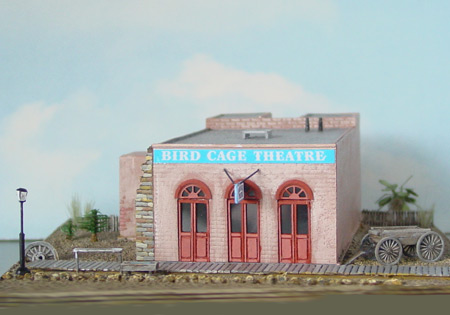
The BIRD CAGE THEATRE . Tombstone, Arizona . 5.5" x 5.5" x 2" tall

The BIRD CAGE THEATRE . Tombstone, Arizona . 5.5" x 5.5" x 2" tall
|
The Bird Cage Theatre, was a saloon, theatre, dancehall, and brothel which opened in 1881, and during it's 9 year life, never closed. It was open 24 hours a day, 7 days a week. It was named for the 14 "bird cage" crib compartments that hang from the ceiling. These "cribs" really were nothing more than small rooms for "ladies", who used these rooms to entertain their clients. The saloon was the site of 16 gunfights, and 140 bullet holes riddle the walls, ceilings, and floors. And there were 26 deaths at the Birdcage. In 1889, when the mines no longer produced silver, and Tombstone's population trickled away, the theatre was boarded up with all its furnishings intact, and stayed closed for over 50 years, until it reopened in 1934, with everything inside preserved in its original state. Even the coin-operated juke box still works. Today the Bird Cage has been converted into a museum. The "bird cages", stage, original curtain, and all furnishings, are still intact. Even the business license issued in 1881 still hangs on the wall. The front exterior has been restored to it's original appearance. Although the theatre closed its doors in 1889, it has not been silent. The sounds of laughing, yelling, and music have been reported to pour out of the theatre at night. Visitors during the day have smelled fresh scents of cigar smoke and the odor of whiskey, even though neither is allowed there now. And there have been reported sightings of people wearing period clothing. The town of Tombstone was known as "The Town too tough to Die" and was the most renowned of Arizona's old mining camps. Ed Schieffelin was a miner in this camp, and his comrades told him that he'd find his tombstone rather than silver. In 1877, Schieffelin discovers a rich claim and names it the Tombstone, and the camp adopted this name for the emerging town. Days of lawlessness and violence followed - climaxing with the infamous Earp-Clanton battle, fought near the rear of the O.K. Corral. When the mining industry dried up completely, the citizenry of Tombstone decided they would focus their time and energy on tourism and restoration. It was a Good call! Today, Tombstone is a Historical American Landmark, and America's best example of our 1880 western heritage. |
| CLOSE THIS PAGE |